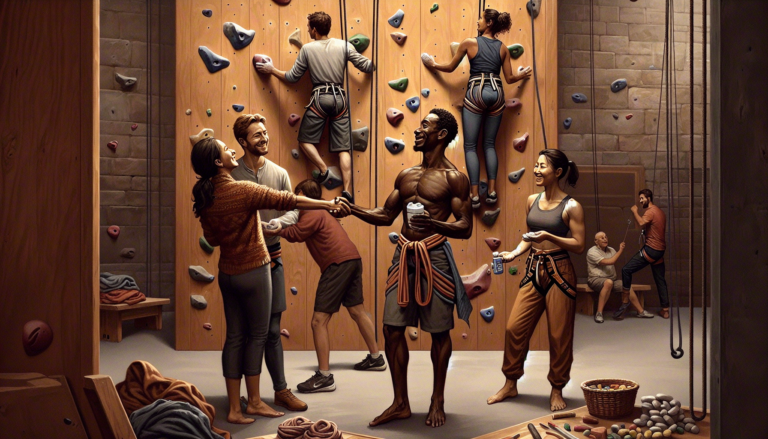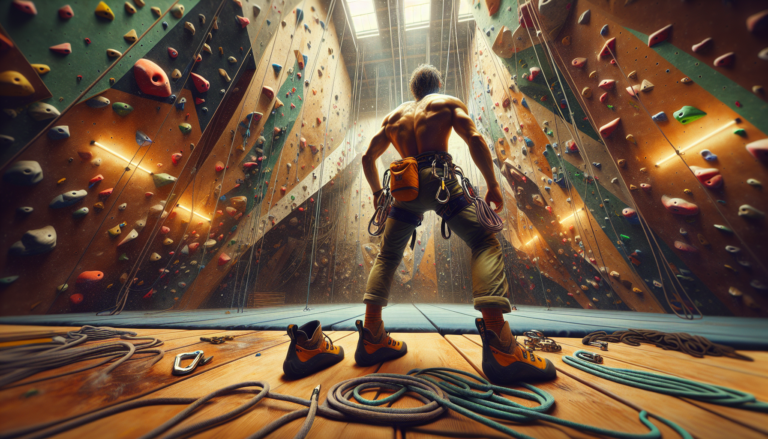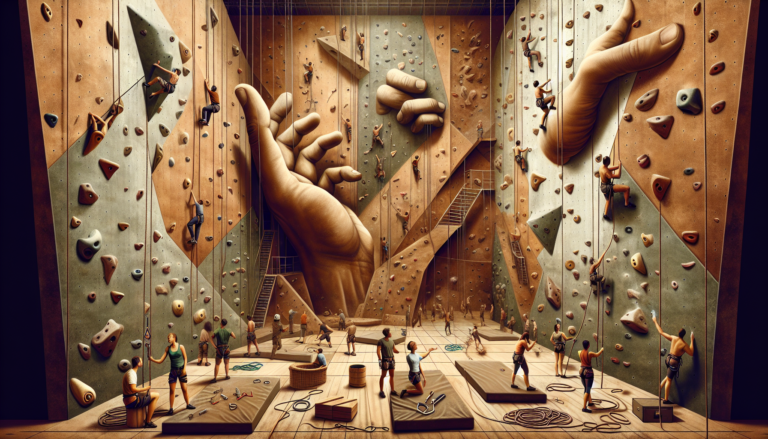Indoor Rock Climbing for Beginners: Complete Guide
Indoor Rock Climbing for Beginners – The Essential Warm-Up for Climbers
Hey there, fellow climber! Whether you’re climbing your first wall or scaling up those mega cliffs like a pro, a solid warm-up is your best buddy. It’ll keep your body humming and help you avoid those pesky injuries.
Why We Do the Wiggle—Dynamic Stretching
So why bother with stretching that gets you wiggling and moving? ‘Cause it’s like prepping your body for the rock-concert climbing is. Think of dynamic stretching as the gentle, upbeat tune-up that gets your muscles singing along. It keeps things flowing—blood, flexibility, and even your climbing mojo.
Here’s the good stuff you’ll get:
- Boosts blood flow flying straight to your muscles
- Makes you as flexible as a gymnast’s rubber band
- Warms up your nerves to get ready for the wall dance
- Stops injuries sneaking up on ya
Try These Warm-Up Moves Before You Climb
Before playing Spider-Man, you gotta gear up with a warm-up routine that gets all systems go! Try tossing these into your mix:
Knee Pull-Ups
- Stand up tall like you own the place and pull one knee up to your chest.
- Hold tight for a few beats, then switch legs.
- Do this dance 10 times for each leg.
Hip Circles
- Feet shoulder-width apart, place your hands on your hips (look at you, all a captain on deck).
- Rotate those hips ’round, clockwise first, then the other way.
- Spin ’em 10 times each direction.
Deep Squats
- Feet apart, squat down as if you’re searching for invisible peanuts on the ground, keep your back like a superhero’s.
- Push those knees out gently.
- Pop back up. Squat! Repeat 15 times.
Arm Circles
- Stretch your arms like Dr. Octopus but keep them in line with the shoulders.
- Spin in small circles, making them bigger each time.
- Go 10 circles one way, then switch it up.
Leg Swings
- Plant yourself on one leg, grab that wall for backup.
- Swing the free leg forward and back, nice and smooth.
- Rock 10 swings a leg.
By weaving these moves into your pre-climb game plan, you’re tuning your body to rock the climbing groove. For more tips on this gig, check out our climbing warm-up exercises guide.
| Move | Count |
|---|---|
| Knee Pull-Ups | 10 per leg |
| Hip Circles | 10 per way |
| Deep Squats | 15 total |
| Arm Circles | 10 per way |
| Leg Swings | 10 per leg |
And hey, don’t forget to cool down after the climb! It’s your chill-out period, where your muscles and brain go, “Ahh.” Think of gentle stretches or a dabble of easy yoga. Scope out our page on climbing endurance training it’ll keep your spirit and stamina fit as a fiddle.
Mastering Climbing Techniques
Let’s kick things off with some solid climbing know-how that’ll keep you hanging around longer with less chance of hitting the mat the hard way. I’m spilling some well-earned wisdom on footwork, body positioning, and balance — essentials for anyone who’s just laced up their climbing shoes.
Footwork Fundamentals
Good footwork is the secret sauce for staying on the wall without getting your arms all noodly. Trust me, it’s less about hauling yourself up by sheer arm power and more about working those legs. I learned this the hard way – if your feet are happy, you’re halfway there. Here are a couple of tricks to make your feet your best climbing buddies:
- Edging: Get cozy with the side of your shoe to grip those tiny holds.
- Smearing: Press your sole flat against the wall where the holds are playing hard-to-get.
Here’s how they stack up:
| Footwork Technique | Best Use | Perks |
|---|---|---|
| Edging | Small holds | Keeps you stable |
| Smearing | Slopes and smooth spots | Grabs onto slippery surfaces |
For more snazzy foot moves, check out basic climbing moves.
Body Positioning Tips
Good body positioning is like your compass in the climbing world, guiding you through different terrains. When facing steep or overhanging walls, you’ll need some nifty tricks to conquer them without turning into a human pretzel. By twisting your hips into the wall and keeping your arms like spaghetti, you conserve energy and avoid looking like a flailing octopus.
Body Positioning Tips:
- Hip Twist: Get that booty into the wall to bring your center of gravity close for less effort.
- Straight Arms: Keep ‘em straight unless you feel like an arm pump contest.
- Flagging: Use that trailing leg like a counterweight on pesky overhangs.
Balance Techniques
Balance – not just for your yoga class. Keeping steady is a biggie in climbing, especially when you’re working on moves that pull you every which way. Here are a few tips that kept me from doing an unplanned dismount:
- Counteract Forces: Balance yourself by shifting weight against gravity’s pull.
- Core Strength: Keep those ab muscles tight for control.
- Flagging: Extend your leg on one side to stay upright and not sideways.
For more advice on staying balanced and other cool climbing moves, pop over to our climbing warm-up exercises guide.
Focus on the essentials, and you’ll soon see your climbing going from “meh” to “heck yeah!” Remember, practice shapes the master, so try different postures and foot techniques to figure out what keeps you stuck to the wall like a pro.
And hey, when you’re ready for some gear loving, we’ve got the goods over at best indoor climbing gear and what to wear indoor climbing to keep you climbing in style.
Climbing Wall Strategies
Trying to conquer different climbing walls can feel like taming a wild beast, especially if you’re just getting started. But guess what? Knowing how to tackle different wall types can totally change your game and make it way more fun.
Steep vs. Vertical Walls
So let’s talk about steep walls versus vertical ones. Steep walls? These bad boys need a bit of a different approach compared to their straight-up cousins. On vertical walls, it’s all about finding that sweet balance and nailing your precision—like a tightrope walker but with more grit. Meanwhile, on those overhanging steep walls, you’ll need Hulk-like strength and some serious energy moves.
Here’s the deal with steep walls: twist your hips into the wall and keep those arms straight. Doing this makes reaching easier and keeps you from wearing yourself out too soon. Oh, and your legs and hips? They’re your best friends. Use them to push yourself upwards with power. This fancy move called “flagging” is key. Picture your back leg maneuvering around to balance your body and stretch you towards your goal.
| Wall Type | Key Moves | Pro Tips |
|---|---|---|
| Vertical | Balance & Precision | Rely on footwork & body positioning |
| Steep | Dynamic & Flagging | Hip twist, arms straight |
Want to dive deeper into these moves? Check our handy basic climbing moves guide.
Overhang Climbing Techniques
Ah, the dreaded overhang! They’ve earned their scary rep, but with the right tricks, you’ll turn them into a playground. It’s all about keeping your body tight like a coiled spring and pushing down hard on those footholds.
For overhangs, moves need to happen fast and on the clock. Your leg and hip game is crucial—thrust up like there’s no tomorrow, keeping those feet glued to the wall. Flagging comes in handy too—it saves you when you’re hanging off balance and stretches you to reach the hold.
| Trick | What’s It’s About |
|---|---|
| Flagging | Balance using a trailing leg |
| Dynamic Moves | Speedy timing and thrust with legs and hips |
Craving more on overhang techniques? Peek into our steep wall climbing tips for a treasure trove of tips.
Utilizing Climbing Volumes
Now, Let’s wrap our heads around volumes—these nifty things shake up your climb like a fun puzzle. When climbing with volumes, you gotta use your thinky muscles and mix up how you hang on to stuff. Get creative with using side-pulls, undercuts, and those ninja-like heel and toe hooks. Best not to overextend and instead, work on moving with balance.
Volumes bring in this extra level of cool by letting you use surfaces like side-pulls or undercuts. They make climbing feel more like a chess game than a tug-of-war.
| Volume Hack | What’s It Do |
|---|---|
| Side-Pulls | Use side surfaces for leverage |
| Undercuts | Grip beneath for stability |
| Heel-Hooks | Hook with your heel for help |
| Toe-Hooks | Use toes to control your climb |
Getting a grip—literally—on these styles can really up your climbing fun. For more advanced techniques, don’t skip our guide on utilizing climbing volumes for in-depth tactics.
Safety Measures in Climbing
When you’re hangin’ off the side of a wall indoors, safety’s kinda important, right? Let’s keep you climbing safely and having fun with these no-nonsense tips.
Harness Fitting and Safety Checks
Let’s get personal with your harness. It needs to hug you just right—not too clingy, but snug enough to stick around when it counts. You know you’ve nailed it if your hand fits in flat but your fist doesn’t get through there.
| Checkpoint | What to Do |
|---|---|
| Waist Belt | Give it the ol’ flat hand test; it should be firm yet friendly. |
| Leg Loops | Snug, but no wedgies, please. |
| Buckles | These little guys should be locked in place, like secrets. |
| Harness Condition | No frays, tears, or holes—if it looks like Swiss cheese, say goodbye. |
Wanna see more on how to suit up? Hop over to our harness guide.
Essential Knots for Climbing
A knotty problem-solving friend—the figure of eight. Everyone loves this one ’cause it’s simple and gets the job done, kinda like mac and cheese for climbers. This knot’s your best buddy, whether you’re scaling a kiddie wall or a mountain.
Tying the Figure of Eight Knot:
- Step 1: Make a loop like you’re going for some macrame art.
- Step 2: Swing the rope end around the other one like it’s a dance party.
- Step 3: Thread it back through the loop. Give it a little tuck.
- Step 4: Pull it taut. Admire your handiwork.
For more knot wisdom, check out our full knots guide.
Belaying Best Practices
Belaying is the unsung hero of the climbing world. It’s a partnership—one person climbs, the other person makes sure the climber doesn’t meet the floor too quickly. Do it right, and you’re golden. Do it wrong, and, well, we won’t talk about that.
Belaying Habits to Master:
- Communication: Stick with phrases like “On belay?” and “Belay on” so there’s no mixed signals.
- Rope Tango: Control the slack—it’s not just extra rope, it’s potential freefall.
- Anchor Rigging: Don’t mess around with this.
- Brake Hand: Like a clutch in stick shift, never let it go.
Curious about more skills? Swing over to our belaying tips.
Safety is everyone’s business—whether you’re a newbie or seasoned pro. Getting your harness right, nailing those knots, and bringing your A-game to belaying puts you on the right path. For more handy dandy tips, sneak a peek at our articles on warm-up exercises and common climbing mistakes.
Climbing Etiquette and Communication
Standard Climbing Commands
When you’re tackling an indoor climbing wall, a little chitchat with your belayer can keep you from taking an unintended dive. Here’s the lingo to make sure you’re both on the same page:
| Command | Meaning |
|---|---|
| “On belay?” | You asking if your belayer’s got your back (or rope). |
| “Belay on” | Your belayer says they’re ready to catch you, just in case. |
| “Climbing” | You announce you’re about to channel your inner Spider-Man. |
| “Climb on” | Your belayer gives the green light to get climbing. |
| “Take” | Need them to tighten the rope? Just holler this. |
| “Lower” | You’re ready to come down from your rooftop balcony. |
Get these calls down, and it’s smooth sailing—or climbing. Fewer surprises, more fun! (SELF).
Indoor Climbing Safety Guidelines
Keeping yourself bruise-free while scaling those walls requires some safety smarts. Here’s how to stay in one piece:
- Harness Fitting: Snug as a bug, that’s how your harness should feel. Need a harness fitting crash course? Check out our how to wear climbing harness guide.
- Belaying Practices: Zone in on your belayer duties—keep that chat going! (How To Climb Harder).
- Knots and Ropes: Get knot-savvy with the Figure 8 and Double Fisherman’s. Trust us, these knots know their stuff.
- Wall Rules: Before you go all Ninja Warrior, read the wall rules. Respect others’ hangout zones, especially when it’s busy.
To level up your safety game, head to indoor climbing mistakes.
Climbing Gym Rules and Etiquette
Think of climbing gym etiquette like being at a fancy dinner—without the suit and tie. Here’s how to keep things cool:
- Respect Routes: Follow the colored paths and don’t mix and match holds unless you’re bouldering.
- Manage Belay Areas: Keep the belay zones clutter-free—your toes will thank you.
- Yield to Climbers: If somebody’s doing their mountain goat impression, wait your turn. Safety first!
- Clean Up: Once you’re done, stash your gear and erase chalk marks. Leave the place tidy.
For even more about gym niceties, visit climbing gym etiquette.
Each gym might sprinkle in their own set of dos and don’ts. Get the lay of the land by checking out the local rules—for everyone’s sake! (How To Climb Harder). Interested in more indoor climbing know-how? Drop by best indoor climbing gear and basic climbing moves for gear tips and fun moves.
Transitioning to Outdoor Climbing
Stepping away from the comfy and safe world of indoor climbing to conquer the wild—or at least, the outdoors—is a journey filled with excitement and a touch of thrill. Let’s talk about how you can get ready to rock those rocks!
Training for Outdoor Climbing
Getting ready for the big outside is like prepping for a mini adventure. It’s about building up your stamina, getting stronger, and fine-tuning your climbing mojo. Hooking up with climbing endurance training is like having a secret weapon in your pocket.
Enrolling in classes aimed at outdoor climbing is like unlocking a treasure chest of golden tips. According to REI, these lessons help you grasp the do’s and don’ts of the wild climb.
| Training Aspect | Focus Areas | How Often? |
|---|---|---|
| Endurance | Long, Steady Climbing Sessions | 2-3 times/week |
| Strength | Fingerboard Fun, Core Boosting | 2 times/week |
| Technique | Dance with Your Feet, Body Grooving | Daily Jam |
Safety Considerations for Outdoor Climbing
The outdoor scene has its curveballs—think unpredictable weather and funky rock formations. Keeping safety in mind is a biggie:
- Get the Right Instruction: Learn from the wise ones—certified instructors or guides can dish out priceless advice (REI).
- Gear Up: Gear makes the climb. While your indoor gear list, like the one in our best indoor climbing gear, is decent, you’ll need extras for outside, like helmets and longer ropes.
- Navigate Like a Pro: Master the art of maps, compasses, and space-age GPS (Climbing).
- Weather Check: Be the weatherman. Keep an eye on Mother Nature, have a backup plan for dodgy weather like whiteouts or storms.
Guided Climbing Expeditions
Guided climbing is your backstage pass to the outdoor climbing concert. These trips are led by super-skilled guides who make sure you stay safe and savvy.
Find a trip that grooves with your climbing vibe:
- Beginner Expeditions: Just starting out? These trips teach you the ropes and keep it chill.
- Intermediate Trips: Ready to level up? Learn cooler moves and chase bigger climbing dreams.
- Advanced Expeditions: For the seasoned climbers wanting to go hard or go home, with expert eyes watching your back.
Sniff around your local climbing gyms or outdoor adventure hubs for expeditions that fit your vibe. They usually have a smorgasbord of trips tailored just for you.
Stick to these tips and lean on expert advice to make your indoor-to-outdoor climbing leap feel like a walk in the park—well, a rocky one. Always put safety and training at the top of your list to squeeze the most out of your climbing shenanigans. Want more climbing nuggets? Check out our sections on basic climbing moves and climbing finger training.
Indoor Climbing Gear and Attire
Hey there, climbing enthusiast! Wanna make sure you’ve got the right gear for your indoor climbing adventure, so you don’t end up as a spider stuck in a web of cables? Here’s a quick chat about the stuff you’ll need if you’re stepping into the world of indoor rock climbing for beginners.
Choosing Proper Climbing Shoes
Let’s talk shoes—because ending up in a slippery situation on a climb isn’t anybody’s idea of fun. You need shoes that stick like gum on a hot summer day. They should be snug and stick to the holds like they’re your best buddy. They might feel a bit like your old gym shoes but without socks. If you’re just getting started and want to keep things cushy, socks are an option (SELF).
Looking for more deets on finding that perfect pair? Check out our take on best indoor bouldering shoes.
| What | Why? |
|---|---|
| Fit | Snug, sticks like glue |
| Sensitivity | Feel every hold |
| Socks | A comforting option for newcomers |
Essential Climbing Gear Checklist
Gear up, buddy! Climbing is more than just sticking shoes to walls. Here’s what’s on the must-have list:
- Harness: A snug buddy that holds you in place. Find out more here.
- Belay Device: A tiny gadget that a climbing buddy might love more than their pet.
- Chalk & Bag: Sweaty palms are not invited to this party.
- Carabiners: True champs that keep the rope in check.
- Helmet (optional indoors): Think of it as a fashion statement outside, protecting the one thing that can’t grow back—your noggin.
| Gear Item | Why It’s Cool |
|---|---|
| Harness | Safety buddy |
| Climbing Shoes | Your wall-sticking pal |
| Belay Device | Keeps friends safe |
| Chalk Bag | “No sweat” trick |
| Carabiners | Rope tamers |
| Helmet* | Noggin saver (mainly outside) |
When you invest in the right climbing equipment, you’re setting up for that sweet moment when you conquer the wall like a boss.
Appropriate Climbing Attire
Now, let’s not forget the fashion part. While looking like you just stepped out of a yoga class is great, we need practicality here. No room for Jonas-inspired puffy jackets.
- Stretch It Out: Think yoga pants or gear—you aren’t doing lunges, but you’ll appreciate the stretch.
- Be Tough: Ensure your clothes can handle brushes with the gritty wall face.
- Move Freely: Overly baggy or too tight is a no-go. You’ve got places to reach!
More on going for that chic, climbing look? Check our guides on best climbing pants, with variety for ladies and the gents.
| Gear Type | Tip Time! |
|---|---|
| Top | Stretchy, keeps you cool |
| Bottom | Tough, fits nicely |
| Goodie Bag | Leave baggy at home |
Getting the essentials right can transform your climbing ventures from “eh” to “epic.” You can snag these goodies at your local climbing gym or fancy outdoor store and try them on to find your match. For extra gear gossip, pop over to REI and Climb On The Rocks.
Advancing Skills and Techniques
Efficient Climbing Movements
Climbing ain’t just about flexing those biceps—it’s more like dancing on a wall. The trick? Nailing down efficient climbing movements. Picture this: you’re scaling those steep walls with your hips and legs doing most of the heavy lifting while your arms just play wingman. Mastering these moves means learning how to time your thrusts upwards and keeping pressure on those footholds. Trust me, slap moves on steep walls will feel like a breeze when you’ve got the right groove going. Don’t believe me? Just ask Climber Magazine.
Problem-Solving Techniques
Rock climbing indoors is like a puzzle game, only with more sweat and chalk dust. Each “problem” or route you tackle is like a brain teaser for your body. Got a challenging problem? Brush off some of these old friends: the back step, drop knee, or even the chic-sounding flagging. Each funky move is your ticket to adding a new layer to your climbing skills. Check out these key ones REI:
| Technique | Description |
|---|---|
| Back Step | Turn those hips away the way the wall hates it |
| Drop Knee | Let a knee drop and twist your bod to conserve strength |
| Flagging | Throw a leg out for balance like a pro dancer |
| Lay-Backing | Push one way, pull the other—confuse the wall |
Improving Climbing Performance
Getting better at climbing isn’t just doing the moves—it’s about prepping like a boss. That basic warm-up routine is gold. Start with knee pull-ups, throw in some hip twirls, and deep squats, and just like that, you’re in climbing beast mode TheClimbingGuy.
To really step up your game, hit the gym for some climbing endurance training and get those fingers rock-solid with climbing finger training. And don’t skimp on good climbing gear or comfy climbing threads—they make a world of difference in both performance and safety. If you wanna dodge the pitfalls or just brush up on basic climbing moves, we’ve got you covered.
Keep at it, and next thing you know, you’ll be scaling those indoor walls like Spiderman.






